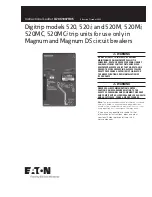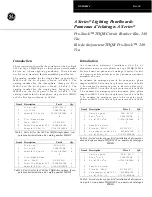
21
(7) Harmonic current
[1] The present value is the effective value during a single cycle.
[2] The present harmonic current value measures the fundamental frequency and order (3rd, 5th, 7th, 9th, 11th, 13th, 15th, 17th, 19th) of each phase
(1-phase, 2-phase, 3-phase, N-phase).
[3] “Each-phase total present harmonic current value” is the total value of the harmonic components for the 3rd, 5th, 7th...17th, and 19th orders
(excluding fundamental frequency components). The calculation formula is shown below.
Setting value
0 to 15 min. (per 1 min.)
Item
Demand time limit
(Each-phase IH (ALL) / each-phase IH (1st))
×
100
(Each-phase IH (3rd), IH (5th),
…
IH (19th) / each-phase IH (1st))
×
100
Each-phase total distortion ratio (%)
Each-phase 3rd, 5th...19th order content ratio (%)
400
±
6.2
5.0
250
±
15.8
12.6
630
800
Accuracy (
±
2.5% of In) (A) (*)
Measurement lower limit current (2% of In) (A)
Measurement upper limit current (In
×
1) (A)
±
10.0
8.0
400
250
630
±
20.0
16.0
800
Rated current In (A)
400
6400
250
4000
±
15% of actual value
630
10080
800
12800
Rated current In (A)
Accuracy
Measurement upper limit fault current (A) (In
×
16)
[4] The all-phase each-order maximum value indicates the maximum value of the present harmonic current values for all phases, from when usage
began (after previous reset) to now.
[5] The demand time limit is a bulk setting value that includes other measurement elements. (Factory setting is 2 min.)
[6] Each-phase total distortion ratio and each-phase order (3rd, 5th, 7th, 9th, 11th, 13th, 15th, 17th, 19th) content ratio are values calculated as follows.
I
AH
= IH
3
2
+ IH
5
2
+ IH
7
2
…
+ IH
17
2
+ IH
19
2
(8) Fault current
[1] The fault current measures the overload/short circuit current.
[2] The measurement accuracy and measurement range for the overload/short circuit current are shown below.
[7] The harmonic current measurement rated value, measurement range, and measurement accuracy are shown below.
[8] Display/communication values will be as follows in the following conditions.
[3] When a fault occurs, the measurement value blinks even if the fault current do not exceed the measurement upper limit value.
(Fault cause/fault current display mode)
When the fault current exceeds the measurement upper limit value, the measurement value blinks even if the fault display mode is released.
* The measurement accuracy is the ratio versus In, regardless of the rated voltage.
Display
Blinks at measurement upper limit
electric current value
Measurement upper limit
electric current value fixed
Communication
0 A
Less than 2% of In
Measurement upper limit current exceeded
Summary of Contents for NF250-HEV
Page 62: ...MEMO ...
Page 63: ......
Page 64: ...Nov 2019 LN107A330H02 IB63E30 A 1911 MEE MDU Breakers ...














































